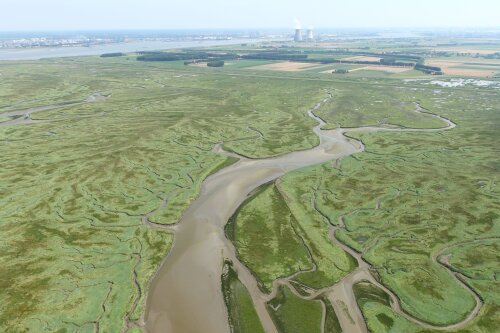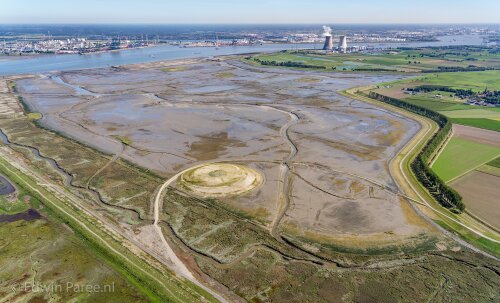Vegetation key to climate resilient coastal wetlands
Coastal wetlands are hotspots of biodiversity as well as significant carbon sinks. They also provide great opportunities to protect our densely populated coastlines and river valleys against the increasing flood risks associated with climate change. Whether tidal wetlands can keep up with sea-level rise, depends largely on a wetland’s ability to accrete sediments fast enough, as well as their potential to drain water efficiently after high tide. Here, the extensive channel networks that dissect coastal wetlands play a pivotal role.
In a new study, published in Nature communications, Olivier Gourgue and Stijn Temmerman (research team EcoSphere, Global Change Ecology Centre), together with Dutch colleagues, shed new light on the important role of vegetation in the formation of these often complexly branching drainage networks.

The ‘Verdronken Land van Saeftinghe’, the largest tidal wetland area along the Schelde, showing the typical branching network of channels that provide sediments at high tide and that drains the wetland at low tide, allowing the wetland ecosystem to persist with sea level rise. Picture source : Rijkswaterstaat, Joop Van Houdt, 2007
Olivier: “The team developed a simplified mathematical model, showing how the presence of marsh plants leads to the formation of more fine-scaled drainage channels. We explain this by the combined effect of plant stems, which by forcing the tidal flow around them lead to the incision of channels, and plant roots, which stabilize the soil and thereby promote the formation of new side-channels.”
The model-based findings were supported with field observations. Vegetation creates a channel network that more efficiently reaches every location on the marsh, implying an improved delivery of sediments during flood tide as well as better drainage during ebb tide. Both processes allow marsh vegetation to maintain itself with rising sea level. This suggests that coastal wetland restoration projects, such as in the Hedwige-Prosperpolder along the Schelde, should aim to promote these natural vegetation processes, as they can make coastal wetlands more resilient to future climate change.
As such, climate-proof wetlands can be created that serve as natural floodplains that buffer extreme high water levels and thereby reduce the flood risks in human-used zones of the river valley, such as the city of Antwerp (see e.g. picture below).

The Schelde estuary (Belgium & the Netherlands), where large tidal marsh ecosystems are restored such as in the Hedwige-Prosperpolder (foreground) which serves as a natural floodplain protecting human activities such as in the port and city of Antwerp (background). Natural processes of vegetation colonization and channel formation will lead to a tidal wetland ecosystem such as found in ‘Saeftinghe’. Picture source : Edwin Paree, 2023